Sustainable Development Goals: Business Ethics in Fashion Industry
VerifiedAdded on 2023/06/18
|9
|2446
|367
Report
AI Summary
This report examines the potential for transforming the fashion industry to align with the UN Sustainable Development Goals (SDGs), particularly Goal 12, which focuses on responsible consumption and production. It highlights the fashion industry's significant environmental impact, including pollution from resource use and synthetic fibers, and advocates for strategies like second-hand shopping, on-demand clothing, ethical fashion choices, and upcycling. The research employs a qualitative approach, gathering primary data through questionnaires from fashion industry professionals to assess the feasibility and importance of implementing sustainable practices. The ultimate aim is to propose the adoption of sustainable production strategies within the fashion industry, contributing to a reduction in waste and pollution and promoting a more environmentally conscious approach.
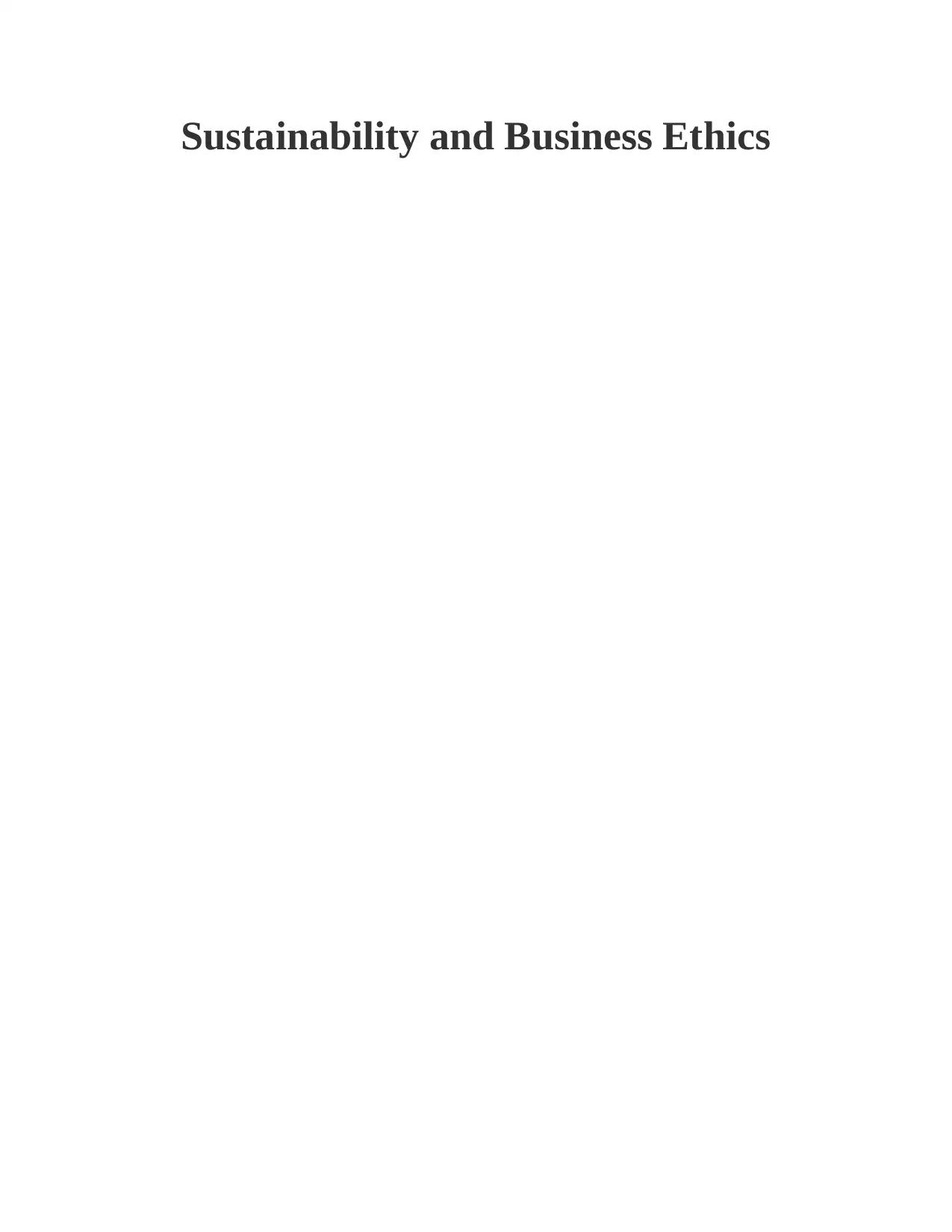
Sustainability and Business Ethics
Paraphrase This Document
Need a fresh take? Get an instant paraphrase of this document with our AI Paraphraser
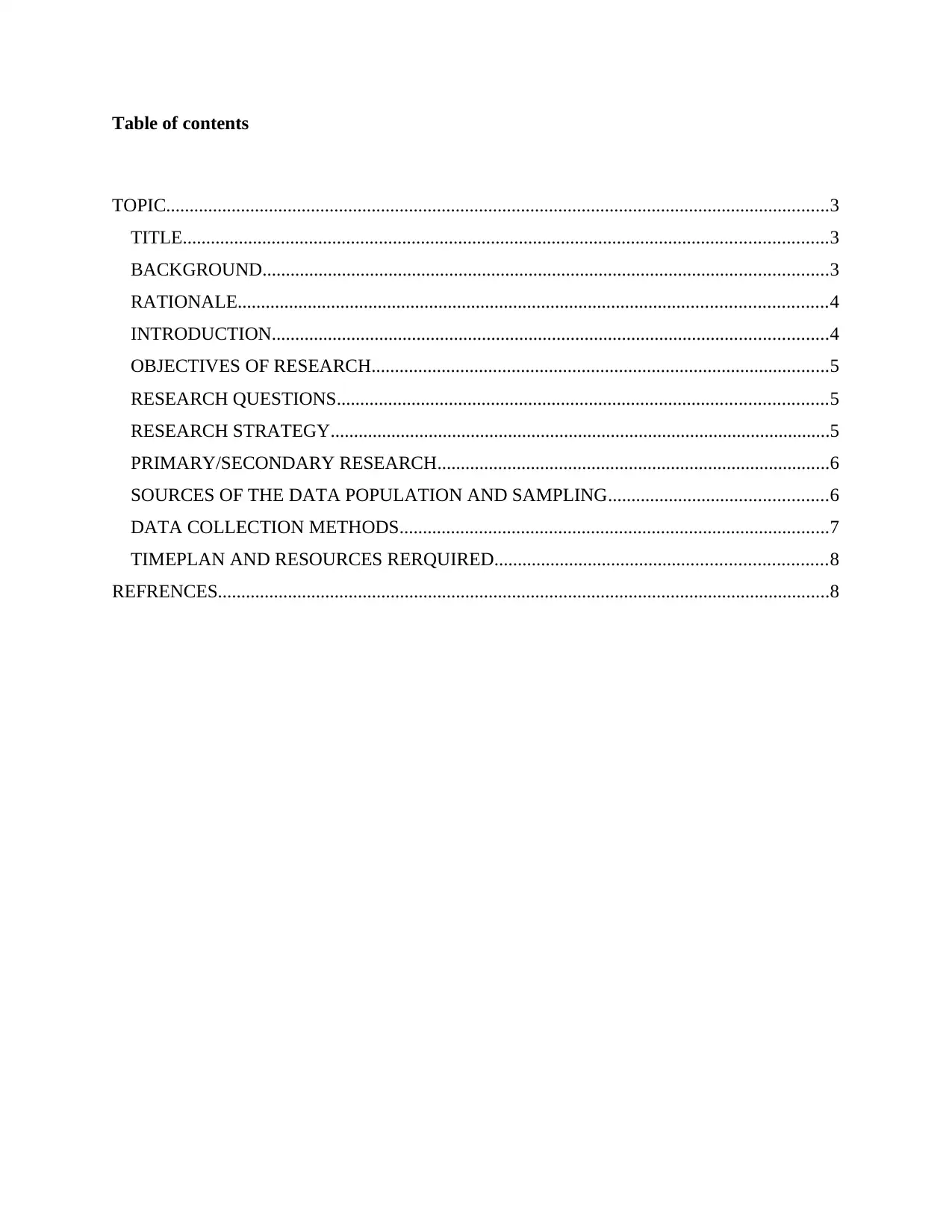
Table of contents
TOPIC..............................................................................................................................................3
TITLE..........................................................................................................................................3
BACKGROUND.........................................................................................................................3
RATIONALE..............................................................................................................................4
INTRODUCTION.......................................................................................................................4
OBJECTIVES OF RESEARCH..................................................................................................5
RESEARCH QUESTIONS.........................................................................................................5
RESEARCH STRATEGY...........................................................................................................5
PRIMARY/SECONDARY RESEARCH....................................................................................6
SOURCES OF THE DATA POPULATION AND SAMPLING...............................................6
DATA COLLECTION METHODS............................................................................................7
TIMEPLAN AND RESOURCES RERQUIRED.......................................................................8
REFRENCES...................................................................................................................................8
TOPIC..............................................................................................................................................3
TITLE..........................................................................................................................................3
BACKGROUND.........................................................................................................................3
RATIONALE..............................................................................................................................4
INTRODUCTION.......................................................................................................................4
OBJECTIVES OF RESEARCH..................................................................................................5
RESEARCH QUESTIONS.........................................................................................................5
RESEARCH STRATEGY...........................................................................................................5
PRIMARY/SECONDARY RESEARCH....................................................................................6
SOURCES OF THE DATA POPULATION AND SAMPLING...............................................6
DATA COLLECTION METHODS............................................................................................7
TIMEPLAN AND RESOURCES RERQUIRED.......................................................................8
REFRENCES...................................................................................................................................8
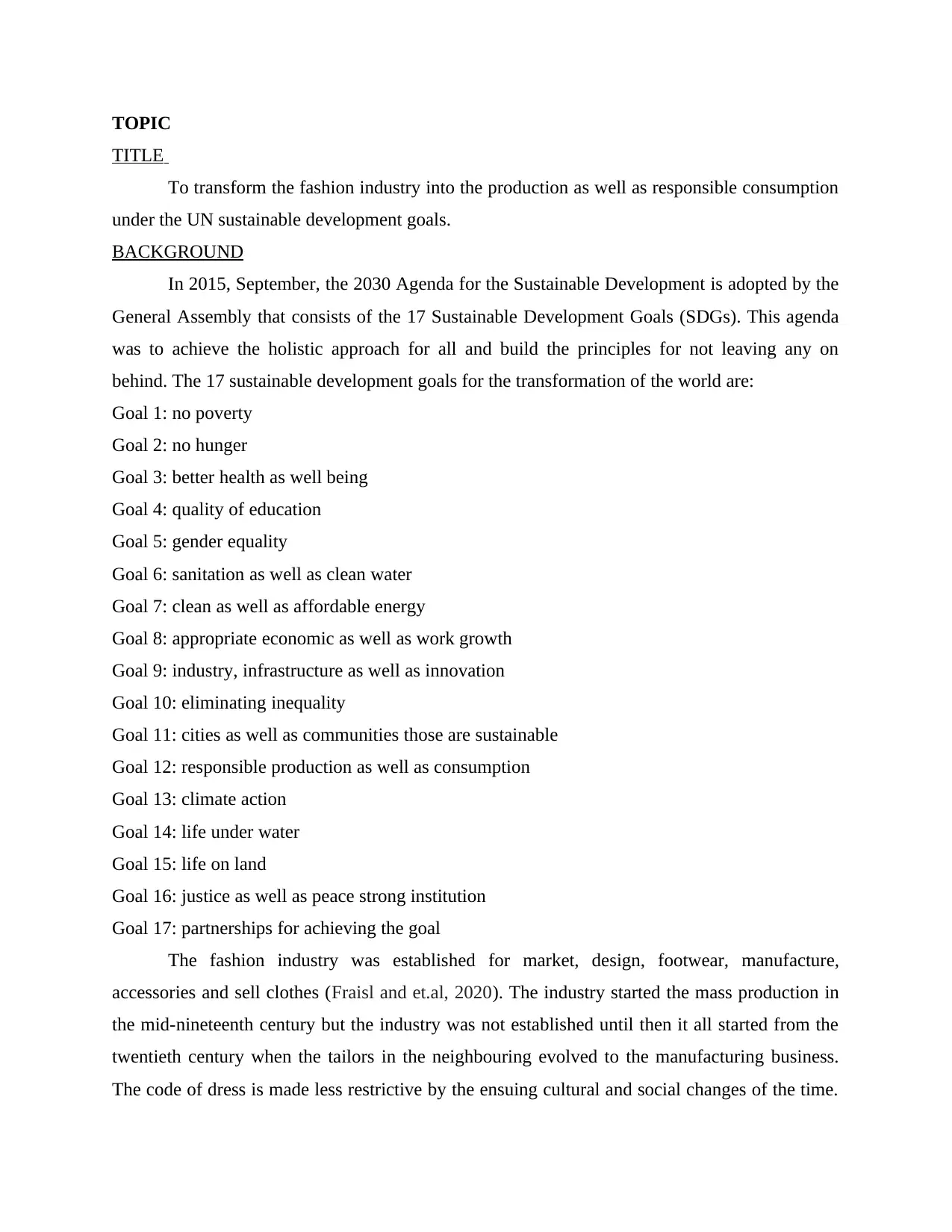
TOPIC
TITLE
To transform the fashion industry into the production as well as responsible consumption
under the UN sustainable development goals.
BACKGROUND
In 2015, September, the 2030 Agenda for the Sustainable Development is adopted by the
General Assembly that consists of the 17 Sustainable Development Goals (SDGs). This agenda
was to achieve the holistic approach for all and build the principles for not leaving any on
behind. The 17 sustainable development goals for the transformation of the world are:
Goal 1: no poverty
Goal 2: no hunger
Goal 3: better health as well being
Goal 4: quality of education
Goal 5: gender equality
Goal 6: sanitation as well as clean water
Goal 7: clean as well as affordable energy
Goal 8: appropriate economic as well as work growth
Goal 9: industry, infrastructure as well as innovation
Goal 10: eliminating inequality
Goal 11: cities as well as communities those are sustainable
Goal 12: responsible production as well as consumption
Goal 13: climate action
Goal 14: life under water
Goal 15: life on land
Goal 16: justice as well as peace strong institution
Goal 17: partnerships for achieving the goal
The fashion industry was established for market, design, footwear, manufacture,
accessories and sell clothes (Fraisl and et.al, 2020). The industry started the mass production in
the mid-nineteenth century but the industry was not established until then it all started from the
twentieth century when the tailors in the neighbouring evolved to the manufacturing business.
The code of dress is made less restrictive by the ensuing cultural and social changes of the time.
TITLE
To transform the fashion industry into the production as well as responsible consumption
under the UN sustainable development goals.
BACKGROUND
In 2015, September, the 2030 Agenda for the Sustainable Development is adopted by the
General Assembly that consists of the 17 Sustainable Development Goals (SDGs). This agenda
was to achieve the holistic approach for all and build the principles for not leaving any on
behind. The 17 sustainable development goals for the transformation of the world are:
Goal 1: no poverty
Goal 2: no hunger
Goal 3: better health as well being
Goal 4: quality of education
Goal 5: gender equality
Goal 6: sanitation as well as clean water
Goal 7: clean as well as affordable energy
Goal 8: appropriate economic as well as work growth
Goal 9: industry, infrastructure as well as innovation
Goal 10: eliminating inequality
Goal 11: cities as well as communities those are sustainable
Goal 12: responsible production as well as consumption
Goal 13: climate action
Goal 14: life under water
Goal 15: life on land
Goal 16: justice as well as peace strong institution
Goal 17: partnerships for achieving the goal
The fashion industry was established for market, design, footwear, manufacture,
accessories and sell clothes (Fraisl and et.al, 2020). The industry started the mass production in
the mid-nineteenth century but the industry was not established until then it all started from the
twentieth century when the tailors in the neighbouring evolved to the manufacturing business.
The code of dress is made less restrictive by the ensuing cultural and social changes of the time.
⊘ This is a preview!⊘
Do you want full access?
Subscribe today to unlock all pages.

Trusted by 1+ million students worldwide
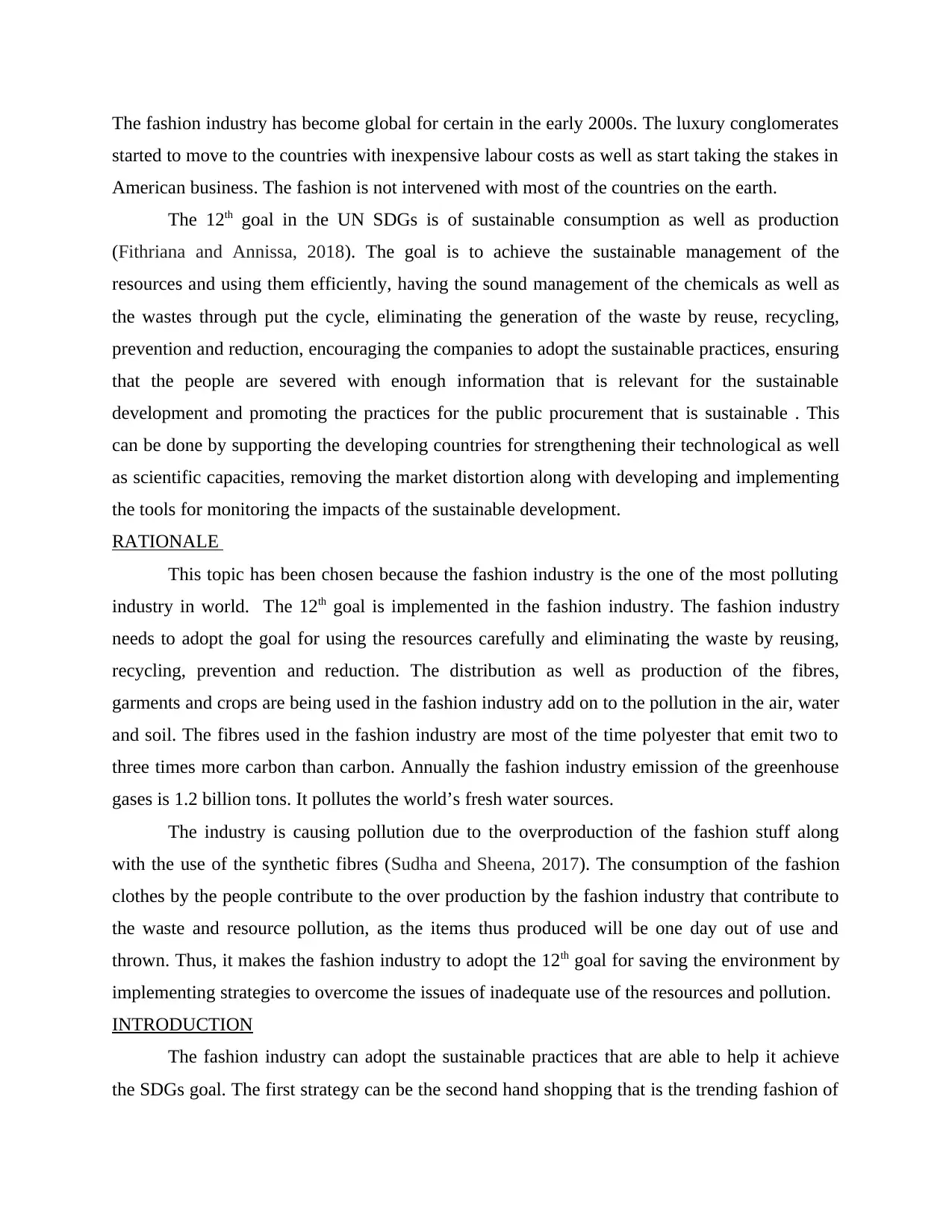
The fashion industry has become global for certain in the early 2000s. The luxury conglomerates
started to move to the countries with inexpensive labour costs as well as start taking the stakes in
American business. The fashion is not intervened with most of the countries on the earth.
The 12th goal in the UN SDGs is of sustainable consumption as well as production
(Fithriana and Annissa, 2018). The goal is to achieve the sustainable management of the
resources and using them efficiently, having the sound management of the chemicals as well as
the wastes through put the cycle, eliminating the generation of the waste by reuse, recycling,
prevention and reduction, encouraging the companies to adopt the sustainable practices, ensuring
that the people are severed with enough information that is relevant for the sustainable
development and promoting the practices for the public procurement that is sustainable . This
can be done by supporting the developing countries for strengthening their technological as well
as scientific capacities, removing the market distortion along with developing and implementing
the tools for monitoring the impacts of the sustainable development.
RATIONALE
This topic has been chosen because the fashion industry is the one of the most polluting
industry in world. The 12th goal is implemented in the fashion industry. The fashion industry
needs to adopt the goal for using the resources carefully and eliminating the waste by reusing,
recycling, prevention and reduction. The distribution as well as production of the fibres,
garments and crops are being used in the fashion industry add on to the pollution in the air, water
and soil. The fibres used in the fashion industry are most of the time polyester that emit two to
three times more carbon than carbon. Annually the fashion industry emission of the greenhouse
gases is 1.2 billion tons. It pollutes the world’s fresh water sources.
The industry is causing pollution due to the overproduction of the fashion stuff along
with the use of the synthetic fibres (Sudha and Sheena, 2017). The consumption of the fashion
clothes by the people contribute to the over production by the fashion industry that contribute to
the waste and resource pollution, as the items thus produced will be one day out of use and
thrown. Thus, it makes the fashion industry to adopt the 12th goal for saving the environment by
implementing strategies to overcome the issues of inadequate use of the resources and pollution.
INTRODUCTION
The fashion industry can adopt the sustainable practices that are able to help it achieve
the SDGs goal. The first strategy can be the second hand shopping that is the trending fashion of
started to move to the countries with inexpensive labour costs as well as start taking the stakes in
American business. The fashion is not intervened with most of the countries on the earth.
The 12th goal in the UN SDGs is of sustainable consumption as well as production
(Fithriana and Annissa, 2018). The goal is to achieve the sustainable management of the
resources and using them efficiently, having the sound management of the chemicals as well as
the wastes through put the cycle, eliminating the generation of the waste by reuse, recycling,
prevention and reduction, encouraging the companies to adopt the sustainable practices, ensuring
that the people are severed with enough information that is relevant for the sustainable
development and promoting the practices for the public procurement that is sustainable . This
can be done by supporting the developing countries for strengthening their technological as well
as scientific capacities, removing the market distortion along with developing and implementing
the tools for monitoring the impacts of the sustainable development.
RATIONALE
This topic has been chosen because the fashion industry is the one of the most polluting
industry in world. The 12th goal is implemented in the fashion industry. The fashion industry
needs to adopt the goal for using the resources carefully and eliminating the waste by reusing,
recycling, prevention and reduction. The distribution as well as production of the fibres,
garments and crops are being used in the fashion industry add on to the pollution in the air, water
and soil. The fibres used in the fashion industry are most of the time polyester that emit two to
three times more carbon than carbon. Annually the fashion industry emission of the greenhouse
gases is 1.2 billion tons. It pollutes the world’s fresh water sources.
The industry is causing pollution due to the overproduction of the fashion stuff along
with the use of the synthetic fibres (Sudha and Sheena, 2017). The consumption of the fashion
clothes by the people contribute to the over production by the fashion industry that contribute to
the waste and resource pollution, as the items thus produced will be one day out of use and
thrown. Thus, it makes the fashion industry to adopt the 12th goal for saving the environment by
implementing strategies to overcome the issues of inadequate use of the resources and pollution.
INTRODUCTION
The fashion industry can adopt the sustainable practices that are able to help it achieve
the SDGs goal. The first strategy can be the second hand shopping that is the trending fashion of
Paraphrase This Document
Need a fresh take? Get an instant paraphrase of this document with our AI Paraphraser
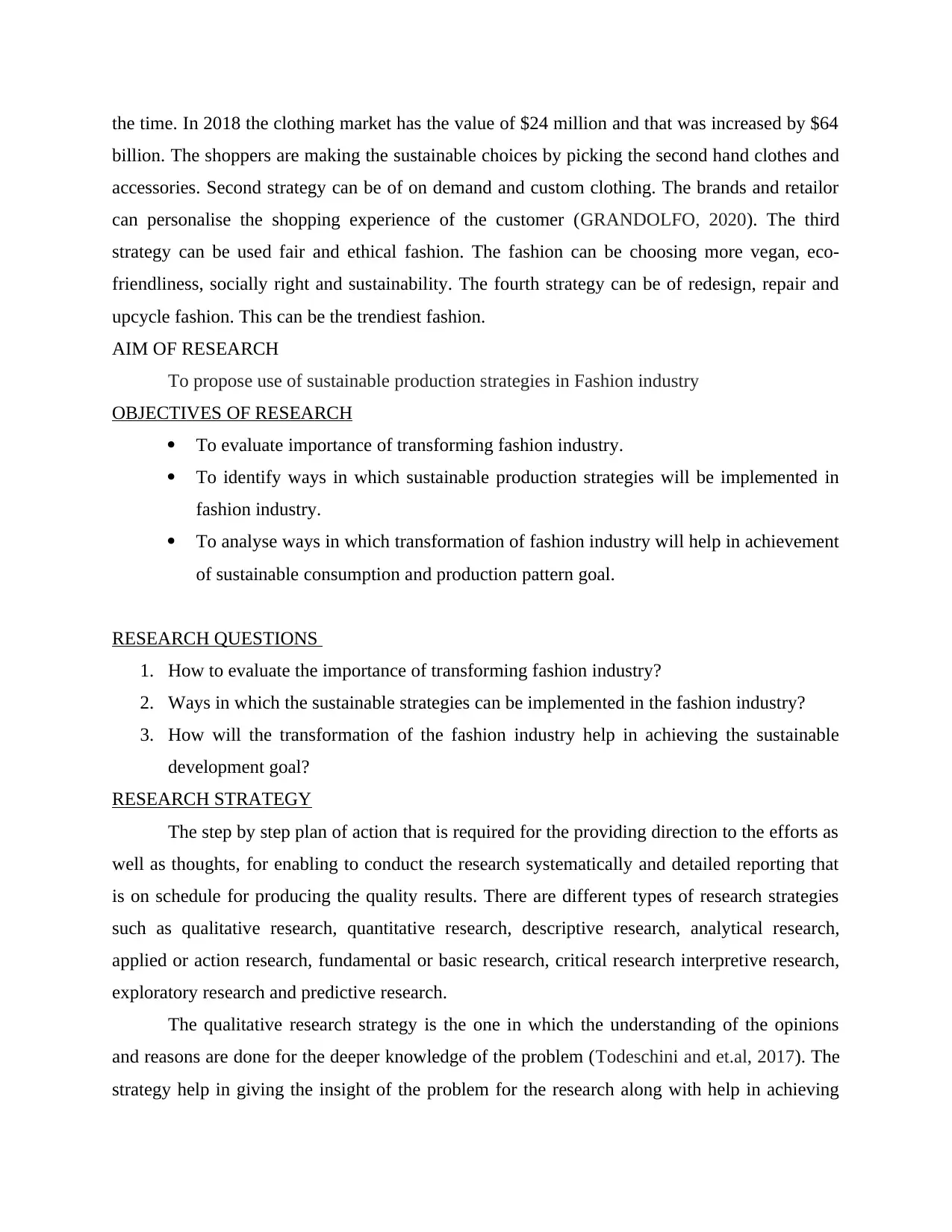
the time. In 2018 the clothing market has the value of $24 million and that was increased by $64
billion. The shoppers are making the sustainable choices by picking the second hand clothes and
accessories. Second strategy can be of on demand and custom clothing. The brands and retailor
can personalise the shopping experience of the customer (GRANDOLFO, 2020). The third
strategy can be used fair and ethical fashion. The fashion can be choosing more vegan, eco-
friendliness, socially right and sustainability. The fourth strategy can be of redesign, repair and
upcycle fashion. This can be the trendiest fashion.
AIM OF RESEARCH
To propose use of sustainable production strategies in Fashion industry
OBJECTIVES OF RESEARCH
To evaluate importance of transforming fashion industry.
To identify ways in which sustainable production strategies will be implemented in
fashion industry.
To analyse ways in which transformation of fashion industry will help in achievement
of sustainable consumption and production pattern goal.
RESEARCH QUESTIONS
1. How to evaluate the importance of transforming fashion industry?
2. Ways in which the sustainable strategies can be implemented in the fashion industry?
3. How will the transformation of the fashion industry help in achieving the sustainable
development goal?
RESEARCH STRATEGY
The step by step plan of action that is required for the providing direction to the efforts as
well as thoughts, for enabling to conduct the research systematically and detailed reporting that
is on schedule for producing the quality results. There are different types of research strategies
such as qualitative research, quantitative research, descriptive research, analytical research,
applied or action research, fundamental or basic research, critical research interpretive research,
exploratory research and predictive research.
The qualitative research strategy is the one in which the understanding of the opinions
and reasons are done for the deeper knowledge of the problem (Todeschini and et.al, 2017). The
strategy help in giving the insight of the problem for the research along with help in achieving
billion. The shoppers are making the sustainable choices by picking the second hand clothes and
accessories. Second strategy can be of on demand and custom clothing. The brands and retailor
can personalise the shopping experience of the customer (GRANDOLFO, 2020). The third
strategy can be used fair and ethical fashion. The fashion can be choosing more vegan, eco-
friendliness, socially right and sustainability. The fourth strategy can be of redesign, repair and
upcycle fashion. This can be the trendiest fashion.
AIM OF RESEARCH
To propose use of sustainable production strategies in Fashion industry
OBJECTIVES OF RESEARCH
To evaluate importance of transforming fashion industry.
To identify ways in which sustainable production strategies will be implemented in
fashion industry.
To analyse ways in which transformation of fashion industry will help in achievement
of sustainable consumption and production pattern goal.
RESEARCH QUESTIONS
1. How to evaluate the importance of transforming fashion industry?
2. Ways in which the sustainable strategies can be implemented in the fashion industry?
3. How will the transformation of the fashion industry help in achieving the sustainable
development goal?
RESEARCH STRATEGY
The step by step plan of action that is required for the providing direction to the efforts as
well as thoughts, for enabling to conduct the research systematically and detailed reporting that
is on schedule for producing the quality results. There are different types of research strategies
such as qualitative research, quantitative research, descriptive research, analytical research,
applied or action research, fundamental or basic research, critical research interpretive research,
exploratory research and predictive research.
The qualitative research strategy is the one in which the understanding of the opinions
and reasons are done for the deeper knowledge of the problem (Todeschini and et.al, 2017). The
strategy help in giving the insight of the problem for the research along with help in achieving
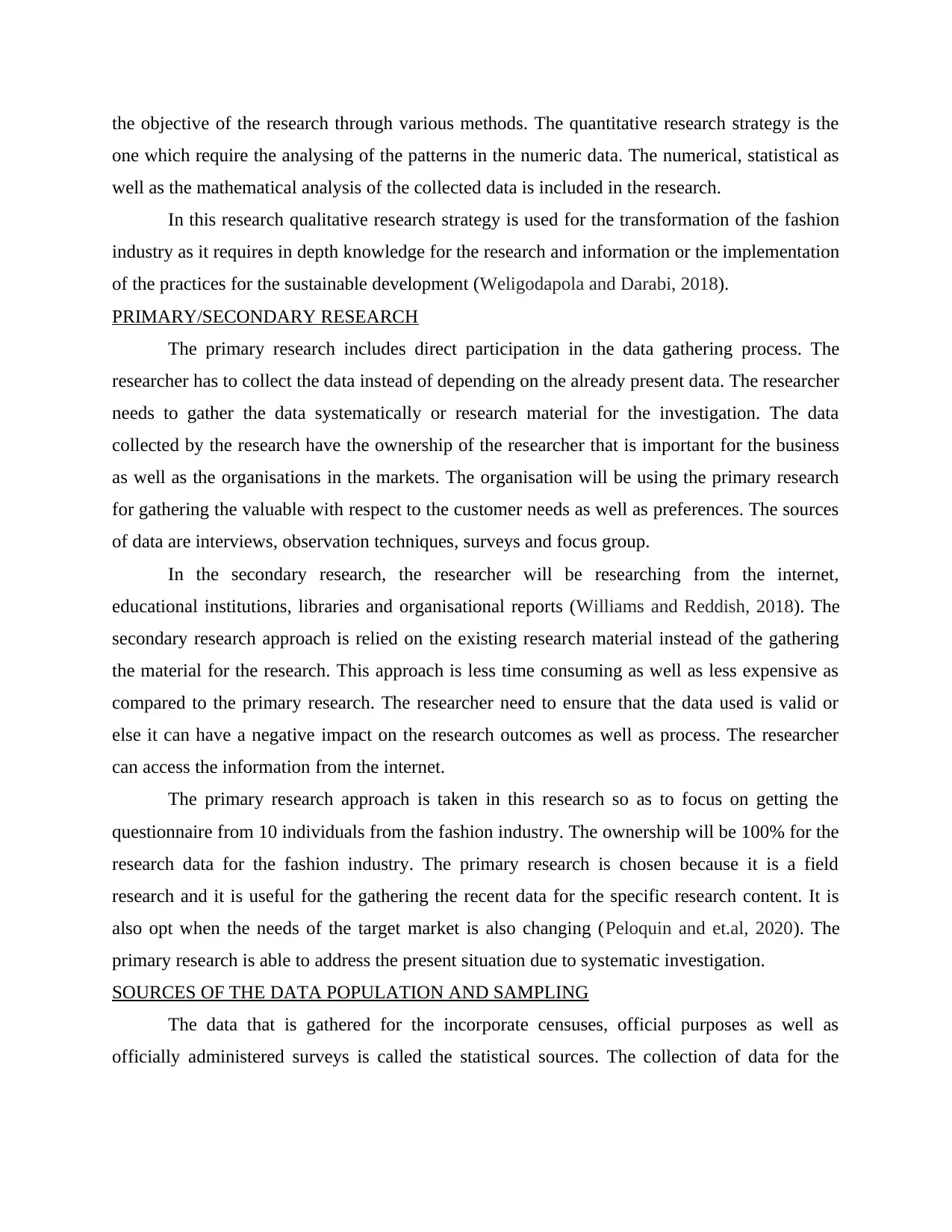
the objective of the research through various methods. The quantitative research strategy is the
one which require the analysing of the patterns in the numeric data. The numerical, statistical as
well as the mathematical analysis of the collected data is included in the research.
In this research qualitative research strategy is used for the transformation of the fashion
industry as it requires in depth knowledge for the research and information or the implementation
of the practices for the sustainable development (Weligodapola and Darabi, 2018).
PRIMARY/SECONDARY RESEARCH
The primary research includes direct participation in the data gathering process. The
researcher has to collect the data instead of depending on the already present data. The researcher
needs to gather the data systematically or research material for the investigation. The data
collected by the research have the ownership of the researcher that is important for the business
as well as the organisations in the markets. The organisation will be using the primary research
for gathering the valuable with respect to the customer needs as well as preferences. The sources
of data are interviews, observation techniques, surveys and focus group.
In the secondary research, the researcher will be researching from the internet,
educational institutions, libraries and organisational reports (Williams and Reddish, 2018). The
secondary research approach is relied on the existing research material instead of the gathering
the material for the research. This approach is less time consuming as well as less expensive as
compared to the primary research. The researcher need to ensure that the data used is valid or
else it can have a negative impact on the research outcomes as well as process. The researcher
can access the information from the internet.
The primary research approach is taken in this research so as to focus on getting the
questionnaire from 10 individuals from the fashion industry. The ownership will be 100% for the
research data for the fashion industry. The primary research is chosen because it is a field
research and it is useful for the gathering the recent data for the specific research content. It is
also opt when the needs of the target market is also changing (Peloquin and et.al, 2020). The
primary research is able to address the present situation due to systematic investigation.
SOURCES OF THE DATA POPULATION AND SAMPLING
The data that is gathered for the incorporate censuses, official purposes as well as
officially administered surveys is called the statistical sources. The collection of data for the
one which require the analysing of the patterns in the numeric data. The numerical, statistical as
well as the mathematical analysis of the collected data is included in the research.
In this research qualitative research strategy is used for the transformation of the fashion
industry as it requires in depth knowledge for the research and information or the implementation
of the practices for the sustainable development (Weligodapola and Darabi, 2018).
PRIMARY/SECONDARY RESEARCH
The primary research includes direct participation in the data gathering process. The
researcher has to collect the data instead of depending on the already present data. The researcher
needs to gather the data systematically or research material for the investigation. The data
collected by the research have the ownership of the researcher that is important for the business
as well as the organisations in the markets. The organisation will be using the primary research
for gathering the valuable with respect to the customer needs as well as preferences. The sources
of data are interviews, observation techniques, surveys and focus group.
In the secondary research, the researcher will be researching from the internet,
educational institutions, libraries and organisational reports (Williams and Reddish, 2018). The
secondary research approach is relied on the existing research material instead of the gathering
the material for the research. This approach is less time consuming as well as less expensive as
compared to the primary research. The researcher need to ensure that the data used is valid or
else it can have a negative impact on the research outcomes as well as process. The researcher
can access the information from the internet.
The primary research approach is taken in this research so as to focus on getting the
questionnaire from 10 individuals from the fashion industry. The ownership will be 100% for the
research data for the fashion industry. The primary research is chosen because it is a field
research and it is useful for the gathering the recent data for the specific research content. It is
also opt when the needs of the target market is also changing (Peloquin and et.al, 2020). The
primary research is able to address the present situation due to systematic investigation.
SOURCES OF THE DATA POPULATION AND SAMPLING
The data that is gathered for the incorporate censuses, official purposes as well as
officially administered surveys is called the statistical sources. The collection of data for the
⊘ This is a preview!⊘
Do you want full access?
Subscribe today to unlock all pages.

Trusted by 1+ million students worldwide
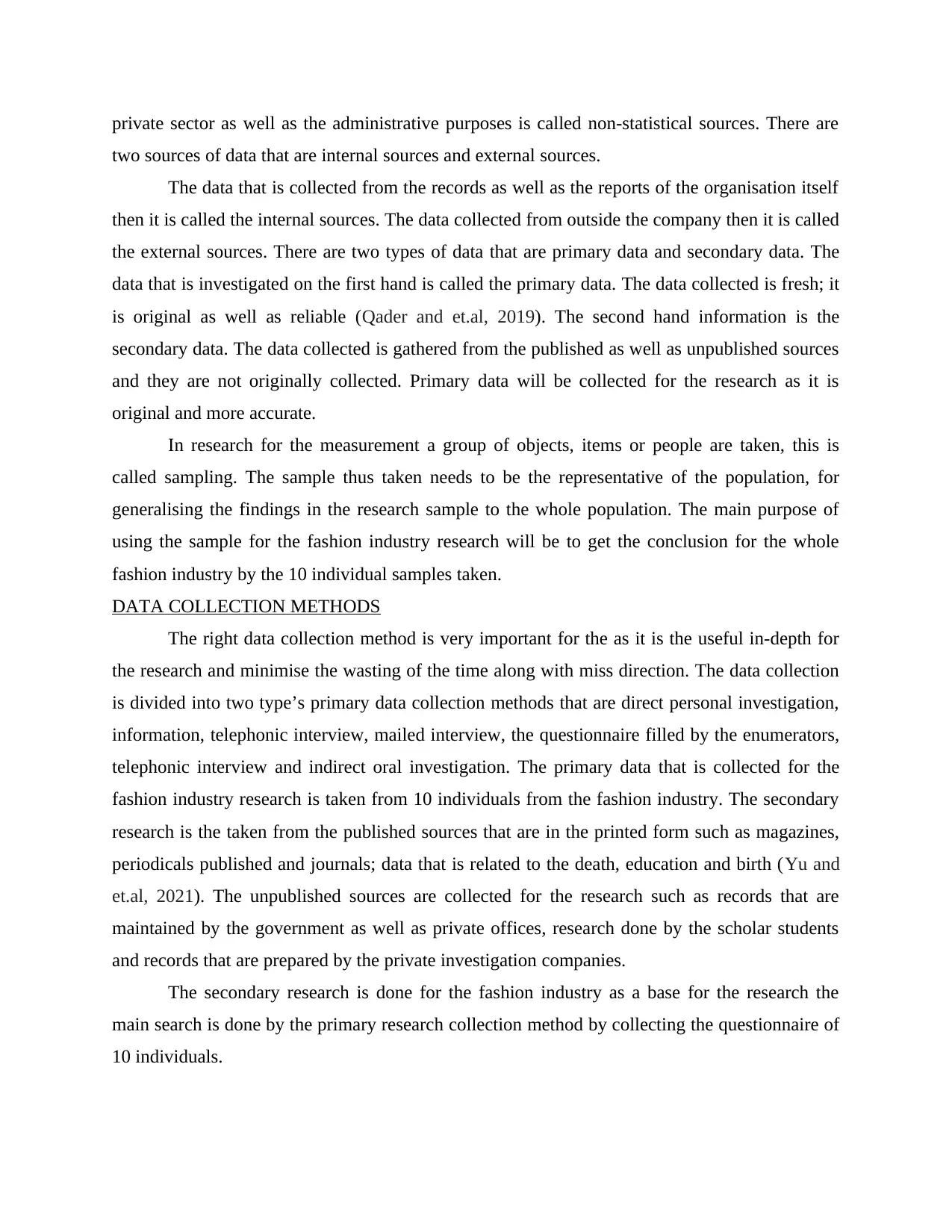
private sector as well as the administrative purposes is called non-statistical sources. There are
two sources of data that are internal sources and external sources.
The data that is collected from the records as well as the reports of the organisation itself
then it is called the internal sources. The data collected from outside the company then it is called
the external sources. There are two types of data that are primary data and secondary data. The
data that is investigated on the first hand is called the primary data. The data collected is fresh; it
is original as well as reliable (Qader and et.al, 2019). The second hand information is the
secondary data. The data collected is gathered from the published as well as unpublished sources
and they are not originally collected. Primary data will be collected for the research as it is
original and more accurate.
In research for the measurement a group of objects, items or people are taken, this is
called sampling. The sample thus taken needs to be the representative of the population, for
generalising the findings in the research sample to the whole population. The main purpose of
using the sample for the fashion industry research will be to get the conclusion for the whole
fashion industry by the 10 individual samples taken.
DATA COLLECTION METHODS
The right data collection method is very important for the as it is the useful in-depth for
the research and minimise the wasting of the time along with miss direction. The data collection
is divided into two type’s primary data collection methods that are direct personal investigation,
information, telephonic interview, mailed interview, the questionnaire filled by the enumerators,
telephonic interview and indirect oral investigation. The primary data that is collected for the
fashion industry research is taken from 10 individuals from the fashion industry. The secondary
research is the taken from the published sources that are in the printed form such as magazines,
periodicals published and journals; data that is related to the death, education and birth (Yu and
et.al, 2021). The unpublished sources are collected for the research such as records that are
maintained by the government as well as private offices, research done by the scholar students
and records that are prepared by the private investigation companies.
The secondary research is done for the fashion industry as a base for the research the
main search is done by the primary research collection method by collecting the questionnaire of
10 individuals.
two sources of data that are internal sources and external sources.
The data that is collected from the records as well as the reports of the organisation itself
then it is called the internal sources. The data collected from outside the company then it is called
the external sources. There are two types of data that are primary data and secondary data. The
data that is investigated on the first hand is called the primary data. The data collected is fresh; it
is original as well as reliable (Qader and et.al, 2019). The second hand information is the
secondary data. The data collected is gathered from the published as well as unpublished sources
and they are not originally collected. Primary data will be collected for the research as it is
original and more accurate.
In research for the measurement a group of objects, items or people are taken, this is
called sampling. The sample thus taken needs to be the representative of the population, for
generalising the findings in the research sample to the whole population. The main purpose of
using the sample for the fashion industry research will be to get the conclusion for the whole
fashion industry by the 10 individual samples taken.
DATA COLLECTION METHODS
The right data collection method is very important for the as it is the useful in-depth for
the research and minimise the wasting of the time along with miss direction. The data collection
is divided into two type’s primary data collection methods that are direct personal investigation,
information, telephonic interview, mailed interview, the questionnaire filled by the enumerators,
telephonic interview and indirect oral investigation. The primary data that is collected for the
fashion industry research is taken from 10 individuals from the fashion industry. The secondary
research is the taken from the published sources that are in the printed form such as magazines,
periodicals published and journals; data that is related to the death, education and birth (Yu and
et.al, 2021). The unpublished sources are collected for the research such as records that are
maintained by the government as well as private offices, research done by the scholar students
and records that are prepared by the private investigation companies.
The secondary research is done for the fashion industry as a base for the research the
main search is done by the primary research collection method by collecting the questionnaire of
10 individuals.
Paraphrase This Document
Need a fresh take? Get an instant paraphrase of this document with our AI Paraphraser
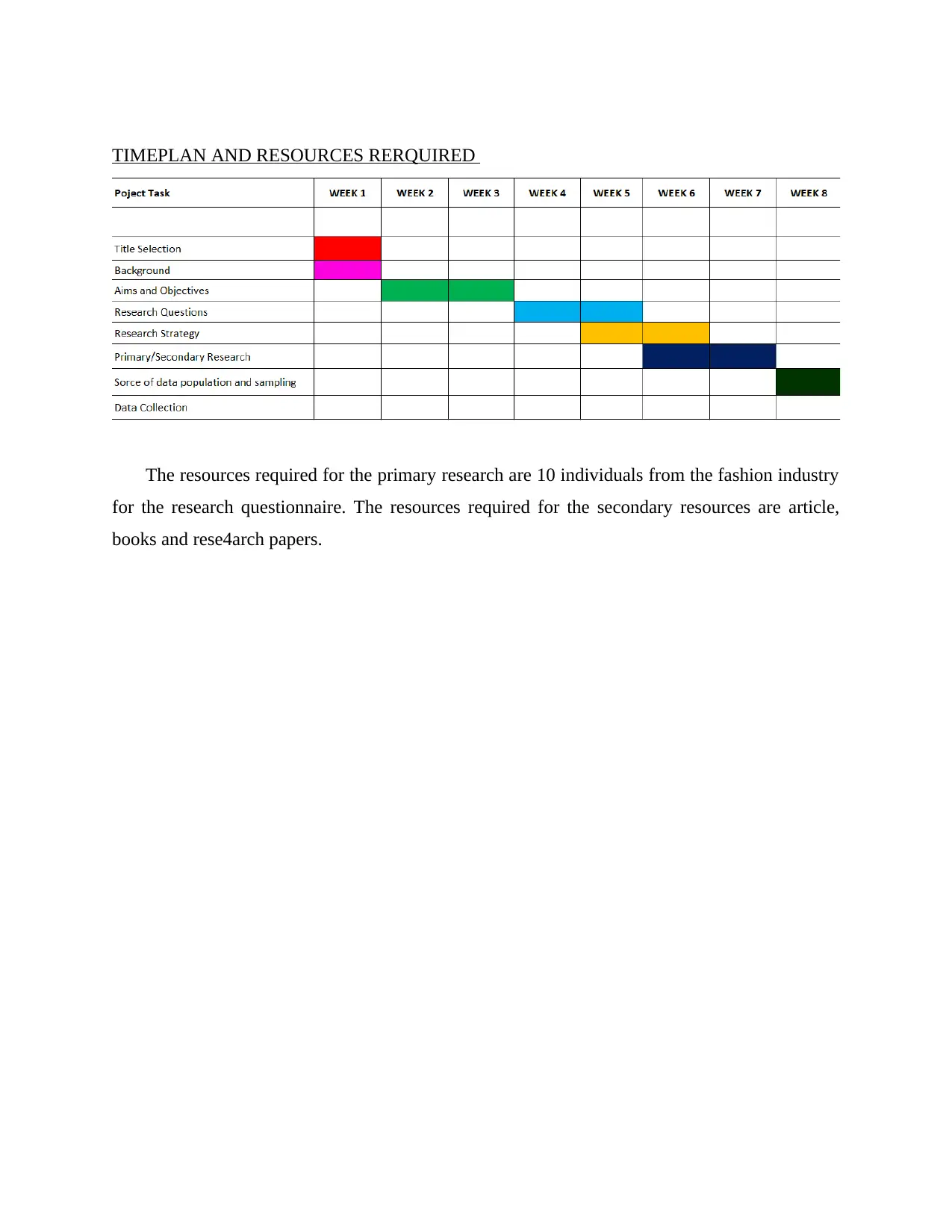
TIMEPLAN AND RESOURCES RERQUIRED
The resources required for the primary research are 10 individuals from the fashion industry
for the research questionnaire. The resources required for the secondary resources are article,
books and rese4arch papers.
The resources required for the primary research are 10 individuals from the fashion industry
for the research questionnaire. The resources required for the secondary resources are article,
books and rese4arch papers.
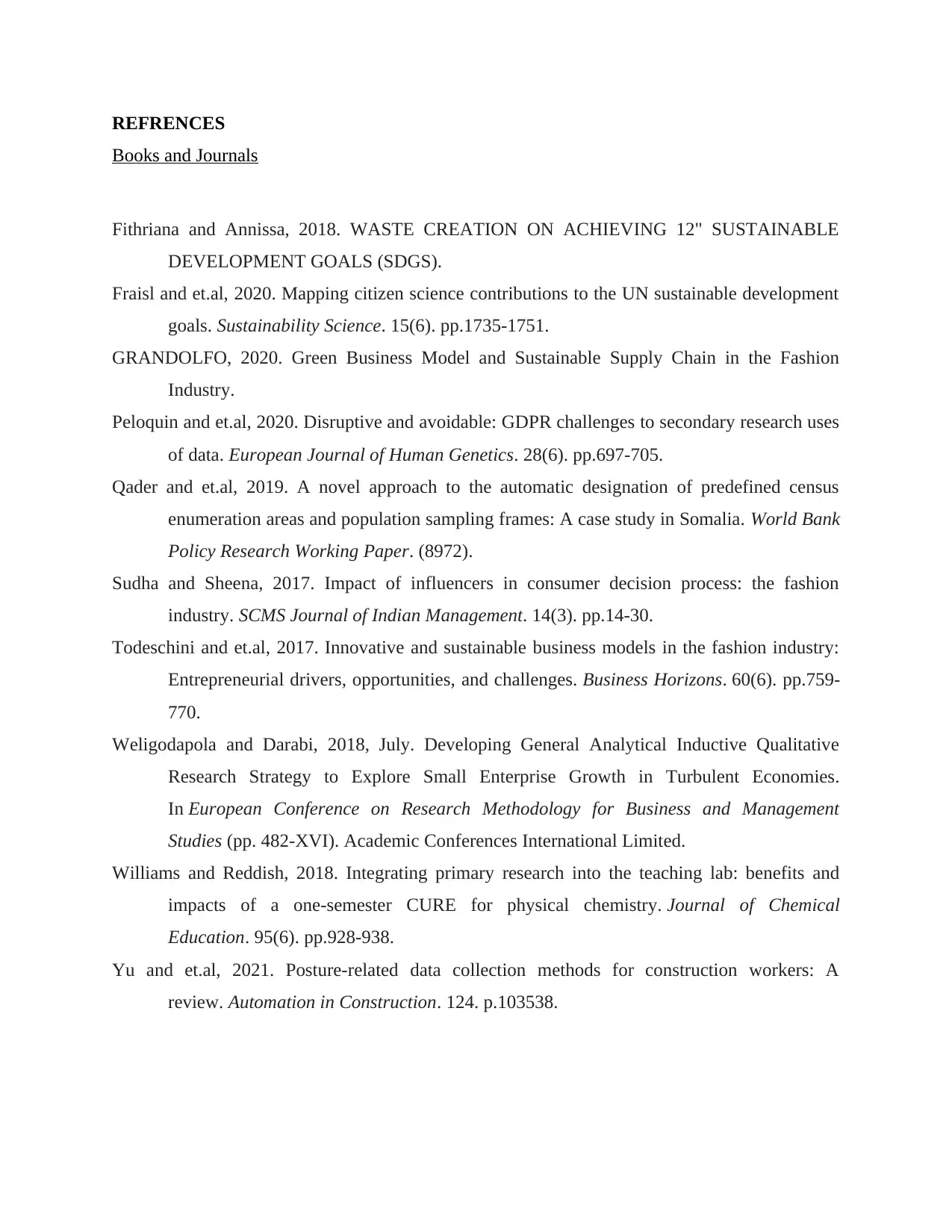
REFRENCES
Books and Journals
Fithriana and Annissa, 2018. WASTE CREATION ON ACHIEVING 12" SUSTAINABLE
DEVELOPMENT GOALS (SDGS).
Fraisl and et.al, 2020. Mapping citizen science contributions to the UN sustainable development
goals. Sustainability Science. 15(6). pp.1735-1751.
GRANDOLFO, 2020. Green Business Model and Sustainable Supply Chain in the Fashion
Industry.
Peloquin and et.al, 2020. Disruptive and avoidable: GDPR challenges to secondary research uses
of data. European Journal of Human Genetics. 28(6). pp.697-705.
Qader and et.al, 2019. A novel approach to the automatic designation of predefined census
enumeration areas and population sampling frames: A case study in Somalia. World Bank
Policy Research Working Paper. (8972).
Sudha and Sheena, 2017. Impact of influencers in consumer decision process: the fashion
industry. SCMS Journal of Indian Management. 14(3). pp.14-30.
Todeschini and et.al, 2017. Innovative and sustainable business models in the fashion industry:
Entrepreneurial drivers, opportunities, and challenges. Business Horizons. 60(6). pp.759-
770.
Weligodapola and Darabi, 2018, July. Developing General Analytical Inductive Qualitative
Research Strategy to Explore Small Enterprise Growth in Turbulent Economies.
In European Conference on Research Methodology for Business and Management
Studies (pp. 482-XVI). Academic Conferences International Limited.
Williams and Reddish, 2018. Integrating primary research into the teaching lab: benefits and
impacts of a one-semester CURE for physical chemistry. Journal of Chemical
Education. 95(6). pp.928-938.
Yu and et.al, 2021. Posture-related data collection methods for construction workers: A
review. Automation in Construction. 124. p.103538.
Books and Journals
Fithriana and Annissa, 2018. WASTE CREATION ON ACHIEVING 12" SUSTAINABLE
DEVELOPMENT GOALS (SDGS).
Fraisl and et.al, 2020. Mapping citizen science contributions to the UN sustainable development
goals. Sustainability Science. 15(6). pp.1735-1751.
GRANDOLFO, 2020. Green Business Model and Sustainable Supply Chain in the Fashion
Industry.
Peloquin and et.al, 2020. Disruptive and avoidable: GDPR challenges to secondary research uses
of data. European Journal of Human Genetics. 28(6). pp.697-705.
Qader and et.al, 2019. A novel approach to the automatic designation of predefined census
enumeration areas and population sampling frames: A case study in Somalia. World Bank
Policy Research Working Paper. (8972).
Sudha and Sheena, 2017. Impact of influencers in consumer decision process: the fashion
industry. SCMS Journal of Indian Management. 14(3). pp.14-30.
Todeschini and et.al, 2017. Innovative and sustainable business models in the fashion industry:
Entrepreneurial drivers, opportunities, and challenges. Business Horizons. 60(6). pp.759-
770.
Weligodapola and Darabi, 2018, July. Developing General Analytical Inductive Qualitative
Research Strategy to Explore Small Enterprise Growth in Turbulent Economies.
In European Conference on Research Methodology for Business and Management
Studies (pp. 482-XVI). Academic Conferences International Limited.
Williams and Reddish, 2018. Integrating primary research into the teaching lab: benefits and
impacts of a one-semester CURE for physical chemistry. Journal of Chemical
Education. 95(6). pp.928-938.
Yu and et.al, 2021. Posture-related data collection methods for construction workers: A
review. Automation in Construction. 124. p.103538.
⊘ This is a preview!⊘
Do you want full access?
Subscribe today to unlock all pages.

Trusted by 1+ million students worldwide
1 out of 9
Related Documents
Your All-in-One AI-Powered Toolkit for Academic Success.
+13062052269
info@desklib.com
Available 24*7 on WhatsApp / Email
![[object Object]](/_next/static/media/star-bottom.7253800d.svg)
Unlock your academic potential
Copyright © 2020–2025 A2Z Services. All Rights Reserved. Developed and managed by ZUCOL.



